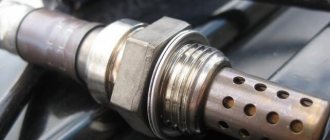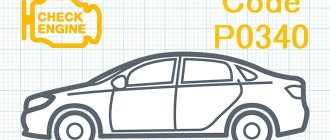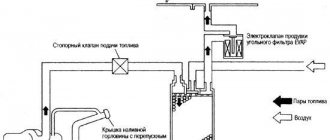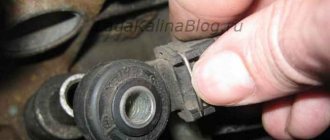Error P0133 is called “insufficient response in the front oxygen sensor circuit,” that is, the slow response of the first lambda probe. This sensor transmits data on the residual oxygen content in the exhaust gases to the ECU. Very often this problem is associated with the quality of the fuel mixture due to bad gasoline or the dying of the lambda itself, although there are a number of other reasons. Error code P0133 is usually accompanied by a loss of engine power, vehicle dynamics, as well as additional sounds from under the car. There are several methods to resolve a slow oxygen sensor response.
Error display p0133
What does this mean
When faced with error code P0133, every motorist is naturally interested in what exactly it is connected to and what node it relates to.
Trouble code P0133 indicates problems with the front oxygen sensor. It's also a lambda probe.
To be more precise, this is evidence that the sensor is characterized by speed that is not typical for stable operation of the system.
The task of the oxygen sensor (lambda probe) is to provide the vehicle's ECU with fresh and correct data on how much oxygen is in the exhaust gas when the internal combustion engine is running.
If the response from the sensor is too slow, the ECU determines this as an incorrect operating mode of the internal combustion engine. That is, error P0133 directly affects the behavior of the power unit.
P0133 decoding
P0133 - Oxygen sensor (OS) circuit slow response, bank 1, sensor 1.
P0133 value
Modern cars are equipped with many sensors that send information depending on engine operating conditions to the ECU. These inputs are then processed by the controller to configure the various outputs to keep the motor running as efficiently as possible.
That's why modern vehicles are able to produce more power while using less fuel and meeting strict emissions regulations.
The DC is a very important input to the control unit as it senses the amount of oxygen in the exhaust stream and allows the ECU to adjust the air/fuel ratio to keep the engine running smoothly and efficiently.
The oxygen sensor associated with code P0133 is installed before the catalytic converter in bank 1. If the vehicle has 4 cylinders, there is usually only 1 bank. If you have a V-twin engine, then you need to find out where bank 1 is located.
A properly functioning upstream oxygen sensor should constantly switch between 0 and 1 volts. When the controller detects that the sensor is not switching quickly enough or is not responding promptly to various driving conditions, it stores a P0133 trouble code.
How serious is P0133?
Typically, a P0133 code is not serious. Although, it should be diagnosed and repaired as soon as possible. You may not notice any symptoms while driving. But this can cause the vehicle to run at the wrong air/fuel ratio, resulting in excessive emissions of harmful exhaust gases.
You will not be able to pass an emissions test with this code, and by ignoring it, you could end up causing a bad catalytic converter, which is very costly.
Bug Prone Cars
If you look at the statistics, you can identify some cars that are more likely than others to encounter this problem.
For VAZ cars, an error with code 0133 is definitely not uncommon. This error is relevant for such models as Lada Vesta, VAZ 2114, Lada Priora, Lada Granta. Although for some reason Vesta appears more often than others.
French and Korean cars were no less susceptible to problems with the oxygen sensor.
Let's start with the French. Renault cars take the lead here. In particular these are:
- Renault Logan
- Renault Duster.
- Renault Sandero.
- Megane.
- Clio.
Among them, error P0133 is quite common.
As for the Koreans, these are mainly the following models:
- Daewoo Matiz and its eternal error P0133.
- Hyundai Accent.
- Hyundai Tucson.
- Kia Cerato.
- Kia Sportage.
- Hyundai Elantra.
In general, the Kia and Hyundai brands have recently become more and more reliable. But you still cannot exclude the possibility that an error like P0133 will appear on the same Kia Sportage or Hyundai Accent of a recent modification.
Separately, it is worth highlighting the Chevrolet Lacetti and Ford Focus 2. In their case, error P0133 is also a frequent companion of car owners. Moreover, the statistics clearly do not speak in favor of the Chevrolet Lacetti.
This is interesting: What is a cabin filter in a car and how to replace it yourself
Other motorists should not relax. Although statistics show superior frequency when the P0133 error occurs in relation to several brands and certain models, potentially every motorist can encounter it. Whether you have a budget Chevrolet Lacetti or some new generation Mercedes. For all of them, error P0133 is a likely malfunction on the part of the oxygen sensor.
How to reset a fault code
You can reset the u0100 error on a Lada Granta with an automatic transmission using the built-in control system; for this you need to:
- Start the engine and let it warm up to operating temperature.
- Turn off the engine.
- Disconnect the battery terminals for 20 minutes.
- Reconnect the terminals.
- Turn the ignition key to position No. 2 and wait 2 minutes.
- Turn the key to its original position (position – “0”).
Error on Lada Granta panel
In this case, there is no need to flash the “brains” of the car. Firmware for the Lada Granta automatic will most likely not help in solving this problem, so you should look for another reason.
In addition to this error, owners of domestic cars may encounter code p0504. Error p0504 on the Granta automatic is a consequence of a faulty brake pedal sensor. As a rule, a spring fails, which could break, as a result of which the contact pad of the sensor does not return to its original position.
This breakdown can be eliminated in the following way - adjust the position of the sensor itself using a special nut that secures it.
If the sensor breaks, it should be replaced. Error p0504 on the Granta automatic machine should disappear.
Signs of an error
It has already been determined that P0133 indicates a slow response of the oxygen sensor.
This can be noticed not only by connecting a scanner or by the lit check engine light on the dashboard. This error is also accompanied by several symptoms:
- there is a noticeable loss of power from the power unit;
- fuel consumption increases for no apparent reason;
- pressing the gas pedal accelerates slower than usual;
- Uncharacteristic sounds are coming from under the hood.
Yes, these are rather indirect signs, since they can appear due to various problems. To get an accurate answer, you should connect to the ECU with a scanner, read the errors and look for code P0133 there. If it is present in the memory of the control unit, you will need to resolve the issue with a faulty oxygen sensor.
Symptoms of malfunction
The main driver symptom of P0133 is the MIL (Malfunction Indicator Light). It is also called Check engine or simply “check light”.
They can also appear as:
- The “Check engine” warning light on the control panel will light up (the code will be stored in the ECM memory as a malfunction).
- Reduced engine power.
- Increased fuel consumption.
- The engine attempts to stall when decelerating.
- Engine jerking during acceleration and after deceleration.
- Other related diagnostic trouble codes may be present.
[stextbox error is not considered serious, the car will be able to start and continue driving. But prolonged neglect can lead to catalyst failure and other consequences.
Error Conditions
Oxygen sensors are installed before and after the catalyst. Information from the front sensor is sent to the ECU to ensure the correct formation of the air-fuel mixture (a system with negative feedback is used). The second sensor (located behind the catalyst) is necessary to monitor the operation of the catalytic converter itself.
Error P0133 does not occur at the first sign of a malfunction. For example, on Kia and Hyundai cars, the sensor diagnostic time is 11 cycles. And the indicator light on the dashboard, indicating a malfunction (Check Engine), turns on only on the third drive cycle.
The main condition for this error to occur is that the time taken by the sensor to signal a change in the state of the air-fuel mixture from “rich” to “lean” is more than 1.75 seconds. In addition, several additional conditions for setting a diagnostic trouble code (DTC) must be met. They may differ for different cars, so we provide information here for the Lada Kalina, popular in our country:
Oxygen sensor
- the coolant temperature must be at least +75°C;
- the fuel supply control system, based on a feedback circuit from the oxygen sensor, is working properly;
- catalyst temperature exceeds +450°C;
- crankshaft rotation speed is in the range of 1440…2880 rpm;
- the load on the motor does not exceed 90%;
- oxygen sensor switching time exceeds 25 seconds;
- The ECU determines that the oxygen content in the exhaust gases is higher than normal.
A slow response of the oxygen sensor, that is, error P0133, can occur for a variety of reasons. Next we move on to their description.
Under what conditions is it diagnosed?
Every car owner needs to know under what conditions a P0133 error is likely to occur.
- A significant period of time for a signal about a change from an enriched heat-air mixture to a lean one emanating from the sensor is 1.75 seconds.
- Increasing the engine coolant temperature to 75⁰С.
- Reducing the switching frequency of the control oxygen sensor to the minimum permissible specified value.
- The temperature of the neutralizer, calculated by the controller, is from 400 to 900 ⁰С.
- Reduce engine load by up to 90%.
- The engine speed range is from 1400 to 3500 rpm.
- Exceeding the level of oxygen in the exhaust gases, recorded by the electronic control unit.
In order to correctly diagnose error P0133, you must perform the following steps:
Carrying out diagnostics
To determine the true cause that led to the appearance of error code P0133, it is necessary to carry out diagnostic measures.
This is done by performing the following procedures:
- Using a multimeter in voltage measurement mode, the parameters of the oxygen sensor at its output are checked.
- The sensor wiring is visually checked for integrity. It is imperative to check whether there are any oil particles or other contaminants on the wires connected to it.
- Visually assess the condition of the sensor housing by removing it from its seat. There should be no traces of overheating, soot, or oil deposits on it.
- Check vacuum hoses and air intakes for leaks and quality of connections.
This is interesting: What are the best means to blacken rubber yourself?
Having detected certain malfunctions, before resetting the error, you will first need to get rid of the very cause of P0133 when reading the ECU with a diagnostic scanner.
Freeze Frame Data
The first step in diagnosis should be to record the freeze frame data associated with P0133. This will show you the operating conditions present when the ECU stored the error.
Wiring Inspection
Once you have the freeze frame data, you should do a simple visual inspection of the oxygen sensor wiring. Look for any frayed, broken or melted wires.
Check the connector for moisture or corrosion. Unfortunately, the oxygen sensor wiring cannot be repaired (unless it is the heater circuit). Therefore, if you find damaged wiring, the sensor will need to be replaced.
Checking for exhaust leaks
Next, start the engine and listen for any exhaust leaks in front of the sensor. Smaller leaks around the exhaust manifold may be more obvious on a cold engine due to thermal expansion. This may also be accompanied by a visual inspection of the exhaust system.
In some rare cases, there are leaks that cannot be heard or seen, but can be detected using a smoke generator installed in the exhaust pipe.
Watch the video on how to make a smoke generator with your own hands:
This shows very small leaks in porous welds that can cause codes related to the oxygen sensor. If leaks are found, repair and clear error codes.
Oxygen sensor test
Once you have checked that the wiring is intact and there are no exhaust leaks, you will need to access the ECU data stream using an OBD2 scanner.
Here you can monitor the voltage coming from the oxygen sensor to the ECU. The voltage should constantly switch between 0 and 1 volt. If the engine is a "V" engine, you can compare bank 1 to bank 2 to see if one shifts faster than the other.
Check the voltage at 2000 rpm, close the throttle quickly, then open it. When the choke closes you should see a voltage close to 0 volts and when it opens again you should see close to 1 volt. All this must happen very quickly, in less than 100 milliseconds.
Again, if you have a dual-cylinder engine, you can compare the two sides to see if one responds more slowly than the other. If the sensor fails the test, replace it.
These tests can also be performed using a digital multimeter. To do this, you will need to find a wiring diagram to determine the purpose of the wires. Also, using the diagram, find and make sure that the sensor has a reliable ground.
Troubleshooting
Having figured out how the error is formed, what provokes it and on what cars it can occur, you need to answer the main question. It concerns how exactly to get rid of the error.
Experts give several recommendations in this regard.
- Using diagnostic equipment in the form of a scanner, check the ECU in deep diagnostic mode. This will open all errors that are in memory. If there are other errors than the one in question, they should be corrected by identifying the causes and then reset. After this, another diagnosis is carried out. It is possible that 0133 was the result of other malfunctions.
- If we are talking about the obvious presence of error P0133 and the reset did not give anything, then you will have to check the condition of the oxygen sensor and the associated components.
- First of all, it is recommended to check the current condition of the catalyst. Make sure there is no internal or external damage. If the integrity of the catalyst is compromised, a new one will need to be installed.
- Using diagnostic equipment, measure the voltage of the signal that comes from the oxygen sensor. This can be done with a regular multimeter set to voltage test mode. When the ignition is turned on, the reading should ideally be around 450 mV. If the ignition is turned off, wait for a reading of approximately 150 mV on the device. If they are different, the sensor needs to be replaced.
- A voltage of less than 150 mV when the engine is turned off supports the theory that the lambda probe is faulty. There is only one solution: replacing it.
- If the voltage is less than 150 mV under the same conditions, there are breaks in the wiring. You need to find them, carry out repairs, or better yet, replace the damaged wiring.
- When the car is equipped with gas equipment, to eliminate the error that appears, you will need to perform the correct settings and select the most suitable mixture. Quite often, it is because of problems with the gas rail that the error in question appears.
- Fuel injectors in the car should be cleaned and washed with special products. Their contamination negatively affects the air-fuel mixture, affects the behavior of the oxygen sensor, and the operation of the latter is ultimately disrupted. This entails the appearance of a corresponding error with code 0133.
- Be sure to check the exhaust system corrugation. Its integrity may be compromised. If the corrugation is burnt out, error P0133 will almost certainly appear until the fault is completely eliminated.
This is interesting: What to do if the cigarette lighter in the car does not work
To summarize, we can say the following. The appearance of error 0133 indicates that there are problems with the oxygen sensor. Its performance is impaired, the device reacts more slowly, which is why the ECU perceives this as an error in the engine’s operation.
The problem is quite common, but not critical. The main trouble is the change in dynamics and the increase in fuel consumption.
Diagnosing a malfunction is not difficult, nor is it difficult to fix it yourself. But sometimes the help of more qualified specialists may be required.
Causes
In practice, a slow lambda probe response can occur for several different reasons.
It is worth highlighting the main ones:
- contamination of the oxygen sensor;
- node failure;
- violation of the integrity of the controller circuits;
- problems with the fuel pump, injectors, steam traps and other components of the fuel system;
- violation of the tightness of the exhaust and intake manifold;
- damage to wiring and oxidation of contacts;
- violation of pressure indicators in the fuel system;
- contamination of the air flow sensor;
- clogged lambda probe holes due to carbon deposits or soot.
There are indeed many potential culprits for the current situation. Here you cannot do without complex diagnostics.
Additional error resolution options
We list for you a few more options that may be useful to car owners of different cars, both domestic and imported:
- Sometimes, with error P0133 on a Hyundai Santa Fe, it is enough to replace the first oxygen sensor with the original one for the error to disappear.
- ECU flashing. This is especially true for Hyundai cars. There is an opinion that Korean software is not suitable for use in Russian conditions.
- The already mentioned sensor replacement (for different cars).
- Replacing a cracked intake manifold or repairing it (welding the housing).
- Cleaning fuel injectors.
- Replacing the crankshaft position sensor (CPS).
- Fill with quality gasoline! This will ensure the correct air/fuel mixture is formed. If you filled in with low-quality gasoline, then try pouring in obviously good fuel and driving the car at high speeds (up to 4000 rpm). If necessary, forcefully erase the error from the ECU memory.
- If you use HBO, check its settings. In some cases, the equipment may produce a mixture that is too rich or lean.
- When using the same gas equipment, an error is possible due to the gas rail. It may not always block the flow of gas to all cylinders, and therefore the oxygen sensor considers the response to be slow. Replacing the rack with a new one helps.
- You can reflash the electronic unit to the Euro 2 standard with software disabling the sensors.
Exhaust system corrugation for Hyundai Accent - On Hyundai Accent cars, the cause of the error may be burnout of the exhaust system corrugation. This is usually accompanied by the appearance of an extraneous sound from under the bottom of the car when you press the gas, an increase in fuel consumption to 13...18 liters per 100 km, as well as a loss of dynamics and power. There is only one way out - replacing the corrugation.
According to statistics, error P0133 most often appears on Hyundai and VAZ cars. However, other car owners are not immune from it. We have tried to collect comprehensive information on this issue for you. We hope that with its help you will be able to troubleshoot problems in your car yourself.
VAZ errors and their solutions
Owners of domestic cars can easily find a problem with their car. This became possible thanks to the use of on-board computers and the introduction of modern equipment diagnostic tools. This article will describe in detail the errors and how to eliminate them in VAZ 2110, 2112, 2114, Kalina, Priora and how to eliminate them.
How to diagnose a car yourself
Do not rush to go to the service center. Although specialists use test benches to detect malfunctions, and their diagnostics are more accurate, every car owner is still able to find out the cause of the problem using information about the error codes of the on-board computer.
To view error codes recorded by the controller:
- Sit behind the wheel, then press and hold the odometer button. It is located at the bottom of the dashboard.
- Turn the key in the lock to position “1”. While turning the key, release the button. This will be followed by a quick set of readings on the instruments.
- After this, press the button again: the display will show the controller firmware version.
- Finally, press the button the last, third time to display the VAZ controller errors.
VAZ error codes:
- P0030 - Oxygen sensor heater before the converter, control circuit open
- P0031 - Oxygen sensor heater before the converter, control circuit short to ground
- P0032 - Heater of the oxygen sensor to the converter, short circuit of the control circuit to the board. net
- P0036 - Oxygen sensor heater after the converter, control circuit open
- P0037 - Oxygen sensor heater after the converter, control circuit short to ground
- P0038 - Heater of the oxygen sensor after the converter, short circuit of the control circuit to the board. net
- P0102 - Mass air flow sensor circuit, low signal level
- P0103 - Mass air flow sensor circuit, high signal level
- P0112 - Air temperature sensor circuit, low signal level
- P0113 - Air temperature sensor circuit, high signal level
- P0116 - Coolant temperature sensor circuit, signal out of acceptable range
- P0117 - Coolant temperature sensor circuit, low signal level
- P0118 - Coolant temperature sensor circuit, high signal level
- P0122 - Throttle Position Sensor Circuit Low Signal
- P0123 - Throttle Position Sensor Circuit High Signal
- P0130 - The oxygen sensor before the converter is faulty
- P0131 - Oxygen sensor circuit to converter, low output level
- P0132 - Oxygen sensor circuit to converter, high output level
- P0133 - Oxygen sensor circuit to the converter, slow response to changes in mixture composition
- P0134 - The oxygen sensor circuit to the converter is inactive
- P0136 - The oxygen sensor after the converter is faulty
- P0137 - Oxygen sensor circuit after the converter, low signal level
- P0138 - Oxygen sensor circuit after the converter, high signal level
- P0140 - The oxygen sensor circuit after the converter is inactive
- P0141 - Oxygen sensor after the converter, heater is faulty
- P0171 - Fuel supply system too lean
- P0172 - Fuel system too rich
- P0201 - Cylinder 1 injector, control circuit open
- P0202 - Cylinder 2 injector, control circuit open
- P0203 - Cylinder 3 injector, control circuit open
- P0204 - Cylinder 4 injector, control circuit open
- P0217 - Engine temperature is higher than permissible
- P0230 - Fuel pump relay circuit malfunction
- P0261 - Cylinder 1 injector, control circuit short to ground
- P0263 - Injector driver fault 1
- P0264 - Cylinder 2 injector, control circuit short to ground
- P0266 - Faulty injector driver 2
- P0267 - Cylinder 3 injector, control circuit short to ground
- P0269 - Injector 3 driver malfunction
- P0270 - Cylinder 4 injector, control circuit short to ground
- P0262 - Cylinder 1 injector, control circuit shorted to on-board network
- P0265 - Cylinder 2 injector, control circuit shorted to on-board network
- P0268 - Cylinder 3 injector, control circuit shorted to on-board network
- P0271 - Cylinder 4 injector, control circuit shorted to on-board network
- P0272 - Faulty injector driver 4
- P0300 - Random/multiple misfires detected
- P0301 - Cylinder 1, misfire detected
- P0302 - Cylinder 2, misfire detected
- P0303 - Cylinder 3, misfire detected
- P0304 - Cylinder 4, misfire detected
- P0326 - Knock sensor circuit, signal output out of acceptable range
- P0327 - Knock sensor circuit low signal
- P0328 - Knock sensor circuit, high signal level
- P0335 - Crankshaft position sensor circuit is faulty
- P0336 - Crankshaft position sensor circuit, signal out of acceptable range
- P0337 - Crankshaft position sensor, short to ground
- P0338 - Crankshaft position sensor, open circuit
- — Malfunction of the camshaft position sensor
- P0342 - Phase sensor circuit, low signal level
- P0343 - Phase sensor circuit, high signal level
- P0346 - Phase sensor circuit, signal output out of acceptable range
- P0351 - Ignition coil of cylinder 1 (1-4), control circuit open
- P0352 - Ignition coil of cylinder 2 (2-3), control circuit open
- P0353 - Ignition coil of cylinder 3, control circuit open
- P0354 - Ignition coil of cylinder 4, control circuit open
- P0363 - Misfire detected, fuel supply to idle cylinders is turned off
- P0422 - Neutralizer efficiency below threshold
- P0441 - Gasoline vapor recovery system, incorrect air flow through the canister purge valve
- P0444 - Canister purge valve, control circuit open
- P0445 - canister purge valve, control circuit short to ground or on-board network
- P0480 - Fan relay, control circuit open
- P0481 - Cooling fan 2 circuit malfunction
- P0500 - Vehicle speed sensor is faulty
- P0506 - Idle system, low engine speed
- P0507 - Idle system, high engine speed
- P0511 - Idle speed control, control circuit faulty
- P0560 - On-board network voltage is below the system operability threshold
- P0562 - On-board voltage, low level
- P0563 - On-board voltage, high level
- P0601 - Engine control system controller, ROM checksum error
- P0615 - Additional starter relay, control circuit open
- P0616 - Additional starter relay, control circuit short to ground
- P0617 - Additional starter relay, control circuit shorted to on-board network
- P0627 - Fuel pump relay, control circuit open
- P0628 - Fuel pump relay, control circuit short to ground
- P0629 - Fuel pump relay, control circuit shorted to on-board network
- P0645 - Air conditioning compressor clutch relay, control circuit open
- P0646 - Air conditioning compressor clutch relay, control circuit short to ground
- P0647 - Air conditioning compressor clutch relay, control circuit shorted to board. net
- P0650 - Malfunction indicator lamp, control circuit faulty
- P0654 - Instrument cluster tachometer, control circuit faulty
- P0685 - Main relay, control circuit open
- P0686 - Main relay, control circuit short to ground
- P0687 - Main relay, control circuit shorted to on-board network
- P0691 - Fan relay, control circuit short to ground
- P0692 - Fan relay, control circuit shorted to on-board network
- P1102 - Oxygen Sensor Heater Resistance Low
- P1115 - Faulty oxygen sensor heating circuit
- P1123 - Rich mixture at idle
- P1124 - Lean mixture at idle
- P1127 - Rich mixture at Partial Load
- P1128 - Lean mixture in Partial Load mode
- P1135 - Oxygen sensor heater circuit 1 open, short circuit
- P1136 - Rich mixture in Light Load mode
- P1137 - Lean mixture in Light Load mode
- P1140 - Measured load differs from calculation
- P1141 - Post-converter oxygen sensor 1 heater malfunction
- P1171 - Low level CO potentiometer
- P1172 - High level CO potentiometer
- P1301 - Cylinder 1, misfire detected, critical for the converter
- P1302 - Cylinder 2, misfire detected, critical for the converter
- P1303 - Cylinder 3, misfire detected, critical for the converter
- P1304 - Cylinder 4, misfire detected, critical for the converter
- P1386 - Knock Channel Test Error
- P1410 - Canister purge valve control circuit short circuit to +12V
- P1425 - Canister purge valve control circuit short circuit to ground
- P1426 - Canister purge valve control circuit open
- P1500 - Fuel pump relay control circuit open
- P1501 - Short circuit to ground of the fuel pump relay control circuit
- P1502 - Short circuit to +12V fuel pump relay control circuit
- P1509 - Idle Air Control Circuit Overload
- P1513 - Idle air control circuit short circuit to ground
- P1514 - Idle air control circuit short circuit to +12V, open
- P1541 - Fuel pump relay control circuit open
- P1570 - Immobilizer, circuit faulty
- P1602 - Engine control system controller, power supply loss
- P1606 - Rough road sensor circuit, signal out of acceptable range
- P1616 - Rough Road Sensor Circuit Low Signal
- P1617 - Rough road sensor circuit, high signal level
- P2301 - Ignition coil of cylinder 1 (1-4), control circuit shorted to board. net
- P2303 - Ignition coil of cylinder 2 (2-3), control circuit shorted to board. net
- P2305 - Ignition coil of cylinder 3, control circuit shorted to board. net
- P2307 - Ignition coil of cylinder 4, control circuit shorted to board. net
We recommend: Car chassis design
Mass air flow sensor
- P0101 - Diagnosis of reality. Air flow is out of range
- P0102 - Low value diagnostics. The signal period is greater than the upper maximum permissible value
- P0103 - High value diagnostics. The signal period is less than the lower maximum permissible value
Intake air temperature sensor
- P0112 - Low value diagnostic. Voltage is less than the lower maximum permissible value
- P0113 - Diagnostics high value. Voltage is greater than the upper maximum permissible value
Coolant temperature sensor
- P0116 - Diagnosis of reality. Temperature is less than calculated value
- P0117 - Low value diagnostic. Voltage is less than the lower maximum permissible value
- P0118 - Diagnostics high value. Voltage is greater than the upper maximum permissible value
Throttle Position Sensors
- P2135 - Diagnostics of the mismatch between the signals of two sensors. The sensor voltages differ by the threshold value
- P0122 - Low value diagnostic (sensor 1). Voltage is less than the lower maximum permissible value
- P0123 - High value diagnostic (sensor 1). Voltage is greater than the upper maximum permissible value
- P0222 - Low value diagnostic (sensor 2). Voltage is less than the lower maximum permissible value
- P0223 - High value diagnostic (sensor 2). Voltage is greater than the upper maximum permissible value
Accelerator pedal position sensors
- P2138 - Diagnostics of the mismatch between the signals of two sensors. The sensor voltages differ by the threshold value
- P2122 - Low value diagnostic (sensor 1). Voltage is less than the lower maximum permissible value
- P2123 - High value diagnostic (sensor 1). Voltage is greater than the upper maximum permissible value
- P2127 - Low value diagnostic (sensor 2). Voltage is less than the lower maximum permissible value
- P2128 - High value diagnostic (sensor 2). Voltage is greater than the upper maximum permissible value
Injectors
- P0201, P0202, P0203, P0204 - Diagnostics of open control circuit. Driver diagnostics
- P0261, P0264, P0267, P0270 - Diagnosis of control circuit short circuit to ground.
- P0262, P0265, P0268, P0271 - Diagnostics of a short circuit in the control circuit to the on-board network.
We recommend: Car heating in Krasnoyarsk - how is it done?
Control oxygen sensor
- P0130 - Signal circuit integrity diagnostics. Voltage is less than the lower maximum permissible value or greater than the upper maximum permissible value
- P0131 - Low value diagnostic. Voltage is less than the lower maximum permissible value
- P0132 - Diagnostics high value. Voltage is greater than the upper maximum permissible value
- P0133 - Slow Response Diagnosis. The signal period is greater than the maximum permissible value
- P0134 - Activity Diagnostics. Voltage is less than the upper maximum permissible value and greater than the lower maximum permissible value
- P0030 - Diagnostics of open circuit of the heater. Driver diagnostics
- P0031 - Diagnostics of a short circuit of the heater circuit to ground.
- P0032 - Diagnostics of a short circuit of the heater circuit to the on-board network.
Diagnostic oxygen sensor
- P0136 - Signal circuit integrity diagnostics. Voltage is less than the lower maximum permissible value or greater than the upper maximum permissible value
- P0137 - Low value diagnostic. Voltage is less than the lower maximum permissible value
- P0138 - Diagnostics high value. voltage is greater than the upper maximum permissible value
- P0140 - Activity Diagnostics. Voltage is less than the upper maximum permissible value and greater than the lower maximum permissible value
- P0036 - Heater circuit open circuit diagnostics. Driver diagnostics
- P0037 - Diagnostics of a short circuit of the heater circuit to ground.
- P0038 - Diagnostics of a short circuit of the heater circuit to the on-board network.
Fuel supply system
- P0171 - Diagnosis of poor mixture composition. Fuel correction coefficients are greater than the upper maximum permissible value
- P2187 - Diagnosis of poor mixture composition (at idle).
- P0172 - Diagnostics of the richness of the mixture. Fuel correction coefficients are less than the lower maximum permissible value
- P2188 - Diagnostics of the richness of the mixture (at idle).
- Engine overheating - P0217. Engine temperature monitoring
Misfire for toxicity
- P0300, P0301, P0302, P0303, P0304 - Diagnosis of the presence of misfires affecting toxicity. The number of misfires is greater than the maximum permissible value
Misfire to protect the converter
- P0363, P1301, P1302, P1303, P1304 - Diagnosis of the presence of misfires affecting the converter. The number of misfires is greater than the maximum permissible value
Knock sensor
- P0326 - Low value diagnostics. Normalized signal level is outside the acceptable range
- P0327 - Low value diagnostics. The normalized signal level is less than the lower maximum permissible value
- P0328 - High value diagnostics. The normalized signal level is greater than the upper maximum permissible value
Crankshaft position sensor
- P0335 - Signal presence diagnostics. Change in air flow in the absence of a signal from the crankshaft position sensor above the maximum permissible value
- P0336 - Diagnosis of reality. The controller counts the wrong number of teeth per revolution of the crankshaft
Camshaft position sensor
- P0340 - Diagnostics of signal presence. The sensor signal does not change when the engine is running
- P0342 - Low value diagnostics. Low sensor signal for several crankshaft revolutions
- P0343 - High value diagnostics. High sensor signal for several crankshaft revolutions
Ignition coils
- P0351, P0352 - Open circuit diagnostics. The primary circuit current is less than the maximum permissible value
- P2301, P2304 - Diagnostics of a short circuit to the on-board network. The primary circuit current is greater than the maximum permissible value
- Neutralizer - P0422. Determining the capacity of stored oxygen by comparing the amplitude range of the control and diagnostic oxygen sensors
Canister purge valve
- P0441 - Functional diagnostics. The response of the idle control system is greater or less than the maximum permissible value
- P0459 - Diagnostics of a short circuit to the on-board network. Driver diagnostics
- P0458 - Diagnostics of a short circuit to ground.
- P0444 - Open circuit diagnostics.
Cooling fan relay 1
- P0692 - Diagnostics of a short circuit to the on-board network. Driver diagnostics
- P0691 - Diagnostics of a short circuit to ground.
- P0480 - Open circuit diagnostics.
Cooling fan relay 2
- P0694 - Diagnostics of a short circuit to the on-board network. Driver diagnostics
- P0693 - Diagnostics of a short circuit to ground.
- P0481 - Open circuit diagnostics.
- Cooling fan - P0485. Diagnostics of cooling fan supply voltage
- Vehicle speed sensor - P0500. Signal presence diagnostics
- Brake pedal sensor - P0504. Diagnostics of sensor signal mismatch time
Onboard voltage
- P0560 - Diagnosis of value validity. voltage in circuits Cl. "30" and Cl. “15” differs by the threshold value
- P0562 - Low value diagnostic. Voltage is less than the lower maximum permissible value
- P0563 - High value diagnostic. Voltage is greater than the upper maximum permissible value
- P1602 - Supply voltage diagnostics. Power failure
Controller
- P1640 - EEPROM diagnostics. EEPROM test error
- P0601 - Software checksum diagnostics. Invalid checksum
- P0606 - Internal controller checks. ADC is faulty
- P2105 - The monitoring module is faulty.
Starter relay
- P0615 - Open circuit diagnostics. Driver diagnostics
- P0616 - Diagnosis of a short circuit to ground.
- P0617 - Diagnostics of a short circuit to the on-board network.
Fuel pump relay
- P0627 - Open circuit diagnostics. Driver diagnostics
- P0628 - Diagnosis of a short circuit to ground.
- P0629 - Diagnostics of a short circuit to the on-board network.
A/C clutch relay
- P0645 - Open circuit diagnostics. Driver diagnostics
- P0646 - Diagnostics of a short circuit to ground.
- P0647 - Diagnostics of a short circuit to the on-board network.
How to remove information about corrected errors from the controller memory
Sometimes, after troubleshooting, error messages remain in memory and periodically appear on the panel.
To clear an error code from memory:
- Write down and check for irrelevant codes that appear.
- Reset the daily mileage readings by pressing the corresponding button, after which the error code is guaranteed to be deleted from memory.
How to get rid of the "Check Engine" message
Sometimes drivers see a glowing orange icon at the bottom of the instrument panel. This is how the computer reports an engine malfunction. Self-diagnosis will not allow you to determine and correct the cause of the motor problem. However, the error often appears on serviceable cars. Therefore, to reset the problem code:
- Turn on the ignition, but do not start the car.
- Open the hood and use a wrench to loosen and remove the negative terminal on the battery.
- After a minute, return the terminal to its original position.
- Close the hood and turn the ignition key to position “0”.
- Turn the ignition back on and start the engine. After a short time the error should disappear.
We recommend: The engine revs poorly - where to look for the problem?
If the above instructions did not help, it is worth carrying out a more accurate diagnosis of the car at a service center in order to correct the problem at an early stage.
How to avoid P0133?
Keeping your exhaust system in good working order is essential for the oxygen sensor to function properly. Keeping your engine in good mechanical condition is also very important, as excess fuel or oil entering the exhaust stream can contaminate the oxygen sensors.
Sources
- https://DriverTip.ru/repair/chto-oznachaet-oshibka-r0133-kak-ispravit.html
- https://etlib.ru/blog/583-oshibka-p0133—prichiny-i-ih-ustranenie
- https://elm3.ru/diagnostika/oshibka-p0133
- https://voditelauto.ru/%D0%BE%D1%88%D0%B8%D0%B1%D0%BA%D0%B0-p0133/
- https://www.drive2.ru/l/535173541998362770/
[collapse]









